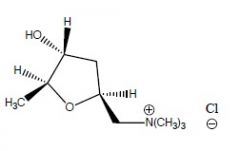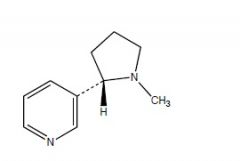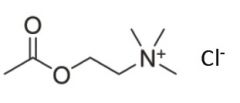![]()
![]()
![]()
Use LEFT and RIGHT arrow keys to navigate between flashcards;
Use UP and DOWN arrow keys to flip the card;
H to show hint;
A reads text to speech;
55 Cards in this Set
- Front
- Back
|
components of PNS (2)
|
autonomic (sympa, parasympa)
somatic |
|
|
acetylcholine properties (2)
|
most exhaustively studied mammal system
functions as NT for many different neurons |
|
|
acetylcholine can be released by...
|
pre and post ganglionic fibers
|
|
|
types of Ach receptors (2)
|
muscarinic
nicotinic |
|
|
muscarine
|
naturally occuring alkaloid (molecule with basic nitrogen
|
|
|
chemical compounds that stimulate the parasympathetic system are called...(2)
|
cholinomimetics or parasympathomimetics
|
|
|
2 possible ways parasympathomimetics can work
|
bind and activate receptors
or block AchE |
|
|
2 names of cholinergic antagonists
|
cholinolytic
parasympatholytic |
|

|
muscarine
|
|

|
nicotine
|
|

|
acetylcholine
|
|
|
muscarinic agonists- what are they used for
|
reestablish smooth muscle tone following surgery
|
|
|
nicotinic agonists- what are they used for
|
to treat myasthenia gravis
|
|
|
muscarinic antagonists what are they used for
|
antispasmodics (overactive bladder, GI spasms, etc)
|
|
|
anticholinergic - used for what
|
muscle relaxant (surgery)
|
|
|
early SAR model of Ach binding to muscarinic receptor
(2) |
imagined to have 2 sites on the receptor:
esteratic and anionic site |
|
|
describe the esteratic and anionic site of muscarinic receptor of early Ach binding SAR model
|
esteratic reacts with O of ester group on Ach
aspartate sits in anionic pocket and binds with quaternary amine |
|
|
what was wrong with the early Ach binding model? (other SAR it could not explain) (4)
|
2 groups on the amine must be methyl groups
there is a known stereochemical preference has no chirality Ing's rule of five |
|
|
what is ing's rule of five
|
all potent cholinergic agonists have only 5 atoms between nitrogen and terminal hydrogens (not counting the O bound to carbonyl)
|
|
|
2 more modern studies regarding SAR of Ach binding
|
computer assisted modeling has refined models to show arrangement of helical bundles and binding sites
GPCR crystal structures have been realized |
|
|
2 different downstream ...effectors...of M receptors
|
adenylate cyclase
phospholipase C |
|
|
M receptor activation and what happens with AC (2)
|
activation of muscarinic Ach receptor causes inhibition of adenylate cyclase
this causes reduction in cAMP in cell |
|
|
M receptor activation and what happens with PLC (3 steps)
|
PLC activation -->cleaves lipid into DAG and IP3
these go on to increase intracellular Ca++ Ca++ activates PKC |
|
|
pirenzipine- what is it?
significance? |
compound found that blocked gastric acid secretion, but did not block effect of muscarinic agonists
discovery led to M receptor subtypes (1-5) |
|
|
structure of pirenzipine?
|
---
|
|
|
mAchR- receptor type
|
GPCRs
|
|
|
structure of GPCR (2)
|
7 TM protein
heterotrimeric (stuck to alpha, beta, gamma subunits) |
|
|
M receptors coupled to Gq
|
odd letters
M1,3,5 |
|
|
M receptors coupled to Gi/o
|
M2,4
|
|
|
M1 receptors- location (5)
|
CNS, gastric, salivary, autonomic ganglia, enteric nerves
|
|
|
M1,3,5 - describe pathway of activation
|
Gq-->
PLC activation increases IP3/DAG leading to increased IC calcium and PKC activation-->depolarization |
|
|
M3 receptors- location (4)
|
CNS, smooth muscle, glands, heart
|
|
|
M5 receptors location (2)
|
low lvls in CNS/periphery
mostly in DA neurons of substantia nigra/vta |
|
|
M2 receptors Location (4)
|
autonomic nerve terminals
CNS heart- lower rate smooth muscle- contract |
|
|
M4 receptors location
|
CNS
|
|
|
3 binding sites of muscarinic receptors
|
Asp (- charge attracts quat amine), Tyr, Thr
|
|
|
G protein process of signalling (5 steps)
|
1) Aby bound to GDP
2) exchange factor switches GDP for GTP upon binding of Ach 3) b-y dissociates to activate stuff downstream 4) alpha has GTPase activity and hydrolyzes GTP to GDP 5) reassociates with By |
|
|
3 specific brain areas where M1 is found
|
cerebral cortex
hippocampus striatum |
|
|
M1 receptor properties (2)
|
sometimes termed "neural" because abundant in brain
implicated in alzheimer's (function/memory/learning) |
|
|
M1 agonists- greatest use
|
alzheimer's
|
|
|
4 characteristics of M2 receptors
found where, effects/roles (3) |
found in abundance in the heart
negative chronotropic and inotropic actions contract smooth muscle autoreceptors |
|
|
M2 autoreceptors- location and what they does
|
located on nerve terminals
affords neural inhibition by decreasing Ach release |
|
|
M3 receptors- found in abundance where 3)
|
found in abundance in smooth muscle and glands
CNS |
|
|
M3 receptor stimulation leads to... (2)
|
stimulation leads to contraction and secretion
|
|
|
M3 receptor drugs
|
antagonists- for overactive bladder
|
|
|
M3 role in CNS
|
decrease NT release
|
|
|
M4 receptors- found in abundance where? (2)
|
found in striatum and basal forebrain
|
|
|
roles of M4 receptor (what happens when it activates) (2)
|
activation in smooth muscle/secretory glands leads to inhibition of K+/Ca++ channels
decreases transmitter release in CNS/periphery |
|
|
M5 receptor role
|
may regulate DA release in CNS
|
|
|
3 places that NAchR are found
|
skeletal NMJ
adrenal medulla autonomic ganglia |
|
|
NAchR type of channel
related to what types of receptors |
ligand gated ion channel
closely related to ion channels like GABAa, glycine, etc |
|
|
NAchR - how they work /are activated
|
unlike in muscarinic receptors with their secondary messenger pathways, it acts more like a gatekeeper. when it is bound, it allows passage of ions (K+/Na+)
|
|
|
NAchR structure (2)
|
pentameric transmembrane proteins
can be made up of a, b, gamma/epsilon, delta |
|
|
NAchR subunits- alpha, gamma, epsilon- explain significance of each
|
alpha1 is only one in muscle
gamma- mostly in development only epsilon- if receptor is mature |
|
|
typical subunit arrangements of NAhR (neuronal) 2
|
(a4)2(b3)3
homomeric- a7-10 (can consist of any 5 of these units) |

